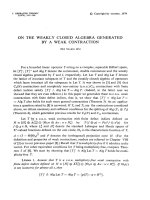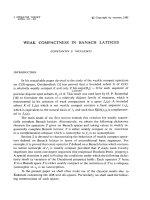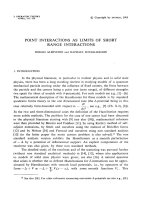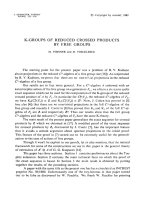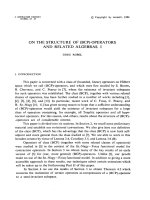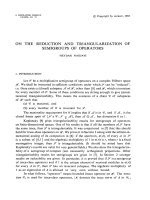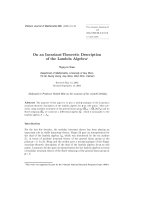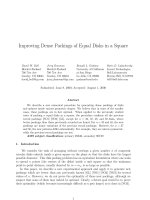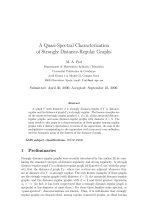Báo cáo toán học: " Envy-free cake divisions cannot be found by finite protocols" pps
Bạn đang xem bản rút gọn của tài liệu. Xem và tải ngay bản đầy đủ của tài liệu tại đây (111.52 KB, 10 trang )
Envy-free cake divisions cannot be found by finite
protocols
Walter Stromquist
∗
Department of Mathematics and Statistics
Swarthmore College, Swarthmore, PA 19081
Submitted: Oct 21, 2007; Accepted: Dec 23, 2007; Published: Jan 7, 2008
Mathematics Subject Classifications: 91B32, 68Q17, 05D05
Abstract
We show that no finite protocol (even if unbounded) can guarantee an envy-free
division of a cake among three or more players, if each player is to receive a single
connected piece.
1 Cutting cakes
An early result for cake cutting [5] is that a cake can always be divided among n players,
using n −1 cuts, in such a way that no player considers another player’s piece to be more
valuable than its own. In this paper we show that no finite protocol can guarantee finding
such a division.
As usual we represent the cake as the unit interval [0, 1]. Possible cuts are points in
the interval and possible pieces are subintervals S = [x, y] ⊆ [0, 1]. The limitation to
n −1 cuts means that each player’s piece consists of a single connected interval. Players’
preferences are represented by nonatomic measures on [0, 1]. We write v
i
for the i-th
player’s measure, and either v
i
(S) or the shorthand v
i
(x, y) for the value to the i-th
player of the piece S = [x, y]. The requirement that the measures be nonatomic implies
that v
i
(x, x) is always zero. (It also allows us to represent pieces as closed intervals without
worrying about the values of the endpoints.) Note that the measures are determined by
the values of F
i
(x) = v
i
(0, x) for all i and x. We assume throughout that v
i
(0, 1) = 1, so
that each v
i
is a probability measure and each F
i
is actually a (cumulative) distribution
function.
∗
This paper arose from discussions at the Dagstuhl Seminar on Fair Division, June, 2007. The author
thanks the organizers of the seminar and all those who make the Dagstuhl program possible.
the electronic journal of combinatorics 15 (2008), #R11 1
For the measures we consider in this paper, v
i
(x, y) is always positive when 0 ≤ x <
y ≤ 1. This implies that the measures are absolutely continuous with respect to each
other, and also that the functions F
i
are bijections on [0, 1]. (This restriction does not
affect the generality of our main result. If finite protocols cannot handle a restricted class
of measures, then they cannot handle a more general class.)
An allocation of pieces to players, piece S
i
being assigned to player i, is called envy
free if v
i
(S
i
) ≥ v
i
(S
j
) for all i and j. The result mentioned above is that for any system
of players’ measures, there is an envy-free division in which each player receives a single
interval. One proof of this result is Su’s argument in [6], which works for all n. Su’s
method is constructive in the sense that an explicit sequence of divisions is constructed,
with the actual envy-free division as its limit. Because it requires convergence, it is not a
finite protocol.
Other non-finite procedures are available in the case of n = 3. A moving-knife al-
gorithm was given in [5], and a simpler moving knife algorithm in [1]. Both of these
procedures involve continuous operations. Since each of the procedures requires that
players watch more than one knife simultaneously, there is no obvious way of replacing
the knives with a finite bidding or trimming process. So these procedures cannot be called
finite, either.
By contrast, there is a simple finite protocol for dividing a cake between two people—“I
cut, you choose.” There is also a finite protocol for envy-free division among three people,
if five cuts are allowed and each player receives two of the resulting six pieces (the Conway-
Guy-Selfridge procedure; see, for example, [2]). One might ask—and Steven Brams did
ask, at the Dagstuhl Fair Division Seminar [3]—whether there is a finite protocol in the
case of three players, two cuts, or more generally n players, n − 1 cuts with n ≥ 3. The
purpose of this paper is to answer this question in the negative.
The first issue, of course, is what constitutes a finite protocol. We address this in
Sections 2 and 3, following the paper by Woeginger and Sgall [7]. We do not require
that the number of steps be bounded in advance; as a consequence, the conclusion of this
paper applies to both bounded and unbounded protocols, as long as they are finite.
In Sections 4 and 5 we prove the main theorem for n = 3. In Section 4 we introduce a
special class of examples which we call “rigid measure systems.” A rigid measure system
consists of three measures v
A
, v
B
, v
C
with certain properties. (When n = 3 we index
the players by i = A, B, C.) A consequence of these properties is that there is a unique
pair of cuts that produces an envy-free division among players with these measures. In
Section 5 we combine these properties to prove that there is no finite protocol for the
case of three players, two cuts, even if we assume that the players’ measures form a rigid
measure system. The case of n > 3 is addressed in Section 6.
One way to understand the proof is to consider the plight of a person who is asked
to guess an arbitrary real number. He is told only whether each guess is too high or too
low. Clearly there is not much hope for a finite protocol. The case of finding an envy-free
division, given a rigid measure system, is similar. One must find exactly the right cuts,
and they are as hard to guess as arbitrary real numbers.
the electronic journal of combinatorics 15 (2008), #R11 2
2 What are finite protocols?
We recommend the paper of Woeginger and Sgall [7] for its discussion of finite protocols,
building on the framework of Robertson and Webb [4]. Like Robertson and Webb, Woeg-
inger and Sgall are concerned with counting steps in their protocols. In this paper we are
only concerned with whether the protocols are finite, which means that we can gloss over
some issues that Woeginger and Sgall treat more completely.
In this paper, a finite protocol is one in which only finitely many marks are made on
the cake. Formally, a mark is a real number x ∈ [0, 1]; informally, it is a physical mark
on the cake that is visible to all players. A protocol proceeds in steps. In each step, the
protocol selects a player i and a real number α, and invites player i to make a mark at the
unique point x for which v
i
(0, x) = α. (Woeginger and Sgall call x the player’s “α-point.”
We assume that the players answer honestly.) After any step, the protocol may terminate
by cutting the cake at n−1 of the existing marks and allocating the pieces to the players.
We assume that whenever a mark is made at x, the players reveal the values of v
j
(0, x)
for all j. As a consequence, the values of v
j
(x, y), for all j and all existing marks x and
y, are common knowledge. Except for this information, the protocol operates without
direct knowledge of the player’s measures. The choices of i and α at each step may be
determined by the protocol in any manner, provided that they are based only on the
existing marks and the knowledge of the players’ measures so far revealed. Similarly, the
choices of whether to terminate at any step, how to cut the cake, and how to allocate the
pieces may be determined in any manner based on the same information.
A protocol is finite if it is guaranteed to terminate after finitely many steps, whatever
the players’ measures. It is bounded if, for some integer N, it is guaranteed to terminate
after at most N steps. Our theorem applies to finite protocols, whether bounded or not.
It is worth restating these notions in the framework of Woeginger and Sgall. They
define two types of queries:
• Marking query: The protocol selects a player i and a real number α; the player
marks the cake at the least x for which v
i
(0, x) = α.
• Value query: The protocol selects a player i and an existing mark x; the player
provides the value of v
i
(0, x).
(Woeginger and Sgall use the word “cuts” for what we call marks. We prefer to reserve
“cut” for a mark that actually becomes the endpoint of some player’s piece.)
The protocol is using the players as oracles. Player i can provide single evaluations of
F
i
(x) (value queries) or F
−1
i
(α) (marking queries). A finite protocol is one that consults
oracles finitely many times.
In this paper we are saying, in effect, that one marking query equals one step. Effec-
tively we are allowing all possible value queries to be made after each step. Since each new
mark enables only finitely many new value queries, this seems like a reasonable convention
for the problem at hand. (It is also used by Robertson and Webb.)
It would not change our result (or proof) if we were to allow steps in which the protocol
calculates a mark directly from the available information. Nor would it matter if we were
the electronic journal of combinatorics 15 (2008), #R11 3
to allow random protocols—since no random protocol can guarantee a result after finitely
many steps unless every realization of it, treated as a deterministic protocol, can make
the same guarantee.
3 Examples of protocols
We give two examples of protocols, one that we accept as finite and one that we reject.
Example: A finite, unbounded protocol that does not work. Consider this
protocol: Enumerate the rational numbers, and for each rational number α, ask each
player to mark the cake at its α-point. Terminate whenever an envy-free division is
possible using existing marks. (Alternatively, we might just as well enumerate the alge-
braic numbers. We could also allow the protocol to mark the cake directly at rational or
algebraic points.)
A protocol of this type would be finite, and would always find an envy-free allocation,
if it were the case that for any set of measures there is an envy-free allocation with rational
piece values (or algebraic values, or rational or algebraic piece widths). We will see in the
next section that there are systems of measures for which no such envy-free allocations
exist. Therefore protocols of this form cannot be guaranteed to terminate.
From here we could head into logical thickets. Given some notion of “constructible”
numbers, we could enumerate them and design a protocol as above. It would find any
envy-free solution in which the piece widths or piece values are all constructible. To draw
the conclusion we want, we must claim that there are measure systems for which no such
envy-free allocations exist. Looking ahead to the next section, we are claiming that there
are rigid measure systems whose parameters x, y, s, t are not constructible numbers. In
effect, the players are allowed to construct their preferences in ways in which the protocol
is not allowed to construct numbers. We will go no further in this direction.
Example: A “cheating” protocol. Consider this sequence of events (from Woeg-
inger and Sgall): The first query is addressed to player 1. The player ignores the content
of the query. Instead, the player codes its entire measure into a real number x, and marks
the cake at x. Each of players 2 through n − 1 then does the same thing. The next
query is addressed to player n, who observes the existing marks, infers the other players’
measures in their entirety, and calculates an envy-free allocation off line, perhaps using
Su’s algorithm. Player n then marks the cake at the point where the first cut should be
made. In response to more queries, player n reveals the rest of the cuts, and then the
algorithm terminates.
This is a finite algorithm that guarantees an envy-free allocation, but it is utterly
foreign to the spirit of cake cutting. We turn away from it in horror.
More practically, we exclude this protocol by requiring that the players answer hon-
estly. As a result, in a finite algorithm, each player is allowed to announce only finitely
many of its α-points. Woeginger and Sgall address this issue further. Considerations
related to this example are the only serious limitation on the kinds of steps we can allow
in a finite protocol.
the electronic journal of combinatorics 15 (2008), #R11 4
4 Rigid Measure Systems
In this section we define rigid measure systems. Let x, y, s, and t satisfy 0 < x < y < 1,
0 < s < 1/3 < t < 1/2, and s + 2t = 1. Then a rigid measure system (RMS) with
parameters x, y, s, t is a set of three measures {v
i
} for i = A, B, C with these two
properties:
1. The density of each measure is always strictly between (
√
2/2) and
√
2. Equivalently:
If S is a piece of length , then
(
√
2/2) < v
i
(S) <
√
2
for every i.
2. The player’s values for the pieces defined by x and y are given by the following table.
[0, x] [x, y] [y, 1]
v
A
t t s
v
B
s t t
v
C
t s t
We need some lemmas about rigid measure systems. The first lemma says that players
in an RMS cannot differ too greatly in their comparisons of two pieces.
Lemma 1 Let i and j be two players with measures in a rigid measure system, and let
S
1
and S
2
be any two pieces. If player i values S
1
as at least twice the value of S
2
, then
player j does not value S
2
as at least twice the value of S
1
. That is: If
v
i
(S
1
) ≥ 2v
i
(S
2
)
then
2v
j
(S
1
) > v
j
(S
2
).
Proof: This is a consequence of the bounds on the densities of the measures. Suppose
S
1
and S
2
have lengths
1
and
2
respectively, and v
i
(S
1
) ≥ 2v
i
(S
2
). Then
2v
j
(S
1
) > 2(
√
2/2)
1
=
√
2
1
> v
i
(S
1
)
≥ 2v
i
(S
2
)
> 2(
√
2/2)
2
=
√
2
2
> v
j
(S
2
).
✷
The next lemma is the reason for calling these systems “rigid.”
the electronic journal of combinatorics 15 (2008), #R11 5
Lemma 2 If v
A
, v
B
, and v
C
form a rigid measure system with parameters x, y, s, t, then
every envy-free division of the cake among A, B, C has cuts at x and y.
Proof: First, cuts at x and y do give an envy-free division—in two different ways.
The pieces [0, x], [x, y], and [y, 1] can be given to players A, B, and C respectively; or,
they can be given to C, A, and B respectively. In each case, each player assigns value t
to its own piece and no more than t to any other player’s piece, so the division is envy
free.
We will see that no other cuts can give an envy-free division. Suppose that instead of
making cuts at x and y, we make them at ˆx and ˆy.
If ˆx ≤ x and ˆy ≥ y with strict inequality in at least one case, then both A and B
would insist on the middle piece. They would each consider its value to be strictly greater
than t, and other pieces’ values to be t or less.
If ˆx ≥ x and ˆy ≤ y with strict inequality in at least one case, then no player would
accept the middle piece. Each player would consider some other piece to have value at
least t, and the middle piece to have value strictly less than t.
By symmetry we are left only to consider the possibility that ˆx ≥ x and ˆy ≥ y with
strict inequality in at least one case. It is clear that both A and C now prefer the leftmost
piece [0, ˆx] to the rightmost piece [ˆy, 1], so if the division is to be envy free the rightmost
piece must be accepted by B. We will show that in that case, A and C both insist on the
leftmost piece.
Let S
1
= [x, ˆx] and S
2
= [y, ˆy]—that is, S
1
and S
2
are the slivers that distinguish cuts
at ˆx, ˆy from cuts at x, y. If B accepts the rightmost piece, it is because
v
B
(ˆy, 1) ≥ v
B
(ˆx, ˆy)
v
B
(y, 1) − v
B
(S
2
) ≥ v
B
(x, y) + v
B
(S
2
) − v
B
(S
1
)
t − v
B
(S
2
) ≥ t + v
B
(S
2
) − v
B
(S
1
)
v
B
(S
1
) ≥ 2v
B
(S
2
).
So B considers S
1
to be twice as valuable as S
2
, and by the previous lemma the other
players must consider S
2
to be less than twice as valuable as S
1
. It follows that
v
A
(0, ˆx) = t + v
A
(S
1
)
= t − v
A
(S
1
) + 2v
A
(S
1
)
> t − v
A
(S
1
) + v
A
(S
2
)
= v
A
(ˆx, ˆy),
so player A insists on the leftmost piece. The same is true of player C by a wider margin.
Therefore no player will accept the middle piece, and no division with cuts at ˆx and ˆy
can be envy free. ✷
The next lemma tells us that one player in a rigid measure system cannot determine
the parameters of the system from its own measure. Further, this remains true even if
the player knows the other players’ measures outside of neighborhoods of the likely cuts.
the electronic journal of combinatorics 15 (2008), #R11 6
Lemma 3 Let v
A
, v
B
, and v
C
form a rigid measure system with parameters x, y, s, t.
Let η > 0, let i be one of the players, and let δ > 0 be such that 1/3 + δ < t < 1/2 − δ.
Let ˆx be sufficiently close to x. Then there exists a rigid measure system ˆv
A
, ˆv
B
, ˆv
C
with
parameters ˆx, ˆy, ˆs,
ˆ
t (for some ˆy, ˆs,
ˆ
t) such that
• ˆv
i
= v
i
; that is, player i’s new measure agrees with its old measure;
• ˆv
j
(u, v) = v(u, v) for all j, u, v if neither u nor v is within η of x or y. That is, all of
the new measures agree with the old measures outside of the specified neighborhoods
of x and y;
• ˆy = y; and
• 1/3 + δ <
ˆ
t < 1/2 −δ.
The requirement that ˆx be sufficiently close to x means that there is an > 0 such
that whenever |ˆx −x| < , the lemma applies. The value of may depend on η as well as
on the measures v
A
, v
B
, v
C
.
The first two conclusions of the lemma mean that player i cannot tell whether it is
participating in the system v
A
,v
B
,v
C
or the system ˆv
A
,ˆv
B
,ˆv
C
. The last two conclusions
are technical requirements that will be needed in the next section.
Proof: For clarity we will consider only the case of i = A. We therefore fix ˆv
A
= v
A
.
(The cases of i = B and i = C are not completely symmetrical to this case, but are very
similar.)
Choose
ˆ
t near t—how near, we will determine as we go along. The first of many
constraints on the choice of
ˆ
t is that 1/3+δ <
ˆ
t < 1/2−δ. Like the remaining constraints,
it can be satisfied by choosing
ˆ
t sufficiently close to t.
Set ˆs = 1 − 2
ˆ
t and choose ˆx and ˆy such that v
A
(0, ˆx) =
ˆ
t and v
A
(0, ˆy) = 2
ˆ
t. This
choice forces ˆy = y. Note that ˆx and ˆy are both continuous functions of
ˆ
t.
We need for ˆx and ˆy to satisfy |ˆx −x| < η and |ˆy −y| < η. These form the second set
of constraints on
ˆ
t, and they are satisfied if
ˆ
t is sufficiently close to v
A
(0, x) = t and 2
ˆ
t is
sufficiently close to v
A
(0, y) = 2t.
Assume that we have chosen
ˆ
t to satisfy the above constraints. We must now construct
the measures ˆv
B
and ˆv
C
. We do this by assigning values to ˆv
B
(0, u) and ˆv
C
(0, u) for each
u; these assignments will determine the measures entirely. We assign:
• ˆv
B
(0, u) = v
B
(0, u) and ˆv
C
(0, u) = v
C
(0, u) if u is not within η of x or y.
• ˆv
B
(0, ˆx) = ˆs and ˆv
B
(0, ˆy)=ˆs +
ˆ
t.
• ˆv
C
(0, ˆx) =
ˆ
t and ˆv
C
(0, ˆy)=ˆs +
ˆ
t.
• Finally, we extend ˆv
B
(0, u) and ˆv
C
(0, u) linearly to values of u in the intervals
[x − η, ˆx], [ˆx, x + η], [y − η, ˆy], and [ˆy, y + η].
the electronic journal of combinatorics 15 (2008), #R11 7
It is clear that ˆv
A
, ˆv
B
, ˆv
C
form a rigid measure system provided that they meet
the density requirements; that is, provided that the densities of ˆv
B
and ˆv
C
stay strictly
between
√
2/2 and
√
2. If they do, then the system clearly has the required parameters
ˆx, ˆy, ˆs,
ˆ
t and meets the requirements of the lemma.
The measures meet the density requirement if the slopes of ˆv
B
(0, u) and ˆv
C
(0, u)
are between
√
2/2 and
√
2 on all four of the intervals to which these functions were
extended linearly. This amounts to sixteen inequalities. We consider only one of them,
the requirement that the slope of ˆv
B
(0, u) be less than
√
2 on the interval [x −η, ˆx]. This
is equivalent to
ˆv
B
(x − η, ˆx) <
√
2 (ˆx − (x − η)) .
Both sides of this inequality are continuous functions of ˆx, and hence of
ˆ
t. The inequality
is true when
ˆ
t = t, because in that case ˆx = x and ˆv
B
has the same slope as v
B
in the
interval. Therefore, this inequality holds if
ˆ
t is in a sufficiently small open neighborhood
of t. The other fifteen inequalities impose similar constraints. So we need only to choose
ˆ
t sufficiently close to t to make all of them hold, and then ˆv
A
, ˆv
B
, and ˆv
C
meet the
requirements of the lemma. ✷
5 There is no finite protocol
Theorem 1 There is no finite protocol that reliably finds an envy-free division of a cake.
Proof: We show that the theorem holds if the players’ measures form a rigid measure
system, even if the protocol is allowed to rely on that fact.
Suppose, on the contrary, that we have such a finite protocol. To reach a contradiction
we will construct a rigid measure system with parameters x, y, s, and t, such that the
protocol does not make a mark at x or y after any number of steps. Since the only envy-
free allocations require cuts at x and y, this means that the protocol cannot terminate
in an envy-free division. This contradicts the assumption that the protocol is finite. The
theorem follows.
We start with any rigid measure system {v
i
} with parameters x, y, s, and t, and make
a sequence of alterations to it as follows. First, fix a value δ > 0 for which 1/3 + δ < t <
1/2 −δ.
Begin the protocol with marks at 0 and 1.
Now let N ≥ 0. Suppose that the protocol has proceeded for N steps, and that no
mark has been made at x or y. Let η > 0 be less than the smallest distance from x or y to
any mark. Allow the protocol to continue through step N + 1; suppose that the protocol
selects player i and real number α and asks player i for its α-point. If the resulting mark
is not at x or y, continue.
Suppose, instead, that the resulting mark is at x or y. Then we need to alter the
measures. From Lemma 3, we can find a number ˆx = x, and a rigid measure system { ˆv
i
}
with parameters ˆx, ˆy, ˆs,
ˆ
t such that
the electronic journal of combinatorics 15 (2008), #R11 8
• v
i
= ˆv
i
;
• v
j
(u, v) = ˆv
j
(u, v) for all j and all existing marks u, v (because all existing marks
are at distance η from x and y);
• ˆy = y; and
• 1/3 + δ <
ˆ
t < 1/2 −δ.
Now we replace the system {v
i
} with the new system { ˆv
i
}. The first two points above
mean that all of the information available to player i, and to the protocol, is identical for
both systems, so player i still answers the (N + 1)-st query with x or y—that is, not with
the new parameters ˆx or ˆy. Answers to previous queries are unchanged as well. So, for
our new rigid measure system, the protocol has failed to find the right cuts through step
N + 1.
Continue in this way. It might be necessary to make infinitely many changes in the
measures. But if we take the additional precaution of choosing the values of η at each
step so that they converge to zero, then only finitely many changes to the measures are
made that affect any point. The successive choices of
ˆ
t are bounded away from 1/3 and
1/2, so that the measures actually converge to a rigid measure system. For that system,
the protocol never makes a mark at the points where the cuts would have to be made. ✷
6 Cases with n > 3
Cases with n > 3 can be handled in exactly the same way. When n = 5, for example,
a rigid measure system has parameters x
1
, x
2
, x
3
, x
4
, s, and t satisfying 0 < x
1
< x
2
<
x
3
< x
4
< 1 and 0 < s < 1/5 < t < 1/2. The measures are governed by the table
[0, x
1
] [x
1
, x
2
] [x
2
, x
3
] [x
3
, x
4
] [x
4
, 1]
v
1
t t s s s
v
2
s t t s s
v
3
s s t t s
v
4
s s s t t
v
5
t s s s t
As in the case of n = 3, we arrange that there are exactly two envy-free allocations, and
both of them require cuts at x
1
, x
2
, x
3
, x
4
. All steps of the proof are exactly the same as
for n = 3.
Acknowledgments
The author thanks the organizers of Dagstuhl Seminar 07261, and many of the partici-
pants, including especially Jiri Sgall, for helpful comments.
the electronic journal of combinatorics 15 (2008), #R11 9
References
[1] Barbanel, Julius B., and Steven J. Brams, “Cake division with minimal cuts: envy-
free procedures for 3 persons, 4 persons, and beyond,” Mathematical Social Sciences
48 (2004) 251-269.
[2] Brams, Steven J., and Alan D. Taylor, “An envy-free cake division protocol,” Amer-
ican Mathematical Monthly 102 (1995) 9–18.
[3] Dagstuhl Seminar 07261, on Fair Division, June, 2007.
[4] Robertson, Jack, and William Webb, Cake-Cutting Algorithms: Be Fair If You Can,
A. K. Peters, 1998 (ISBN 1568810768).
[5] Stromquist, Walter R., “How to Cut a Cake Fairly,” American Mathematical Monthly
87 (1980) 640–644. See also addendum, 88 (1981) 613–614.
[6] Su, Francis Edward, “Rental Harmony: Sperner’s Lemma in Fair Division,” Ameri-
can Mathematical Monthly 106 (1999) 430–442.
[7] Woeginger, G. J., and Jiri Sgall, “On the complexity of cake cutting,” Discrete
Optimization 4 (2007) 213–220.
the electronic journal of combinatorics 15 (2008), #R11 10
